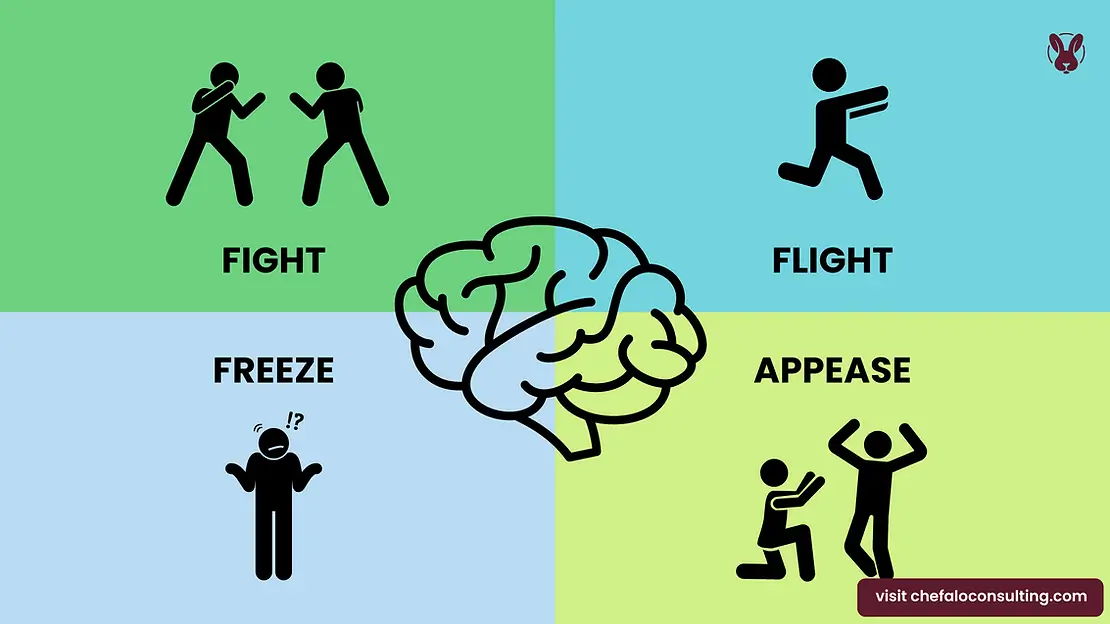Trauma is pervasive and often overlooked. By understanding how our survival instincts (also known as trauma brain or fight, flight, freeze, appease) show up in everyday life, we become better able to respond instead of react–and create safer social norms, no matter what communities we are part of.

The hard truth is that trauma is an inevitable part of life. Whether yourself, a loved one, or a neighbor, coworker, guest, client, or student–I can guarantee that someone in your life has experienced trauma. And the likelihood that they carry it with them is high. Trauma healing can take a lifetime, and many of us never learned how to cope with stress, let alone chronic stress.
By understanding the four trauma responses, we become better able to recognize trauma at work. And, when we can recognize the telltale signs of a trauma response, we are empowered to respond instead of react, which prevents re-traumatization and supports healing-centered environments.
Trauma responses are deeply personal to each individual, and there’s no way of knowing (and understanding) someone’s triggers without developing a strong relationship with them.
However, as a general rule of thumb, the fight, flight, freeze, appease trauma response is triggered whenever someone feels unsafe or in danger. Oftentimes, subtle interpersonal interactions can trigger a trauma response because of unaddressed disruptions in early attachment.
The language of “triggers” has become a buzzword that is often misused. In our trauma-informed approach, when we refer to someone being triggered, it means that they have slipped into “trauma brain mode” and have lost access to their executive functioning.
When we lose access to this part of our brains due to a triggering experience, we struggle (and often fail) to use our critical thinking and logical reasoning skills; regulate our emotions (and the physical experiences that often accompany them); and plan, organize, or problem-solve.
As you can imagine, this often results in situations where someone “wasn’t acting like themselves,” regrets their decisions/behaviors, or even harms themselves or others (intentionally or unintentionally).

Our brains have evolved complex mechanisms to help us survive perceived threats. These survival instincts are extremely useful to us, as they can save our lives in emergency situations. However, we must acknowledge that this state of mind is often activated even when our lives aren’t actually in immediate danger.
These survival instincts are known as trauma responses (or “trauma brain,” as we like to call it at Chefalo Consulting).
While the “fight or flight” response is relatively well-known, there are actually four primary responses:
fight
flight
freeze
appease (often referred to as fawn)
Understanding these responses is essential for fostering trauma-informed environments across our lives and communities, including in our personal and professional relationships.

The fight response is the body’s way of confronting a perceived threat head-on. When faced with danger, our sympathetic nervous system triggers the release of adrenaline and cortisol, preparing us to defend ourselves.
This might manifest as anger, irritability, or even physical aggression. Physiologically, you might experience increased heart rate, rapid breathing, and heightened muscle tension. This response was evolutionarily advantageous, allowing our ancestors to confront and potentially overpower threats.
In modern contexts, the fight response can still emerge, even when the “threat” is a more psychological or emotional one. For example, during a heated argument or when facing criticism, you might feel a surge of defensiveness or even a strong urge to “fight back” verbally or emotionally.
If you’ve ever felt a stubbornness you can’t explain, that may also be your brain’s way of “fighting” someone with this trauma response!

For some of us, in some situations, confronting the actual or perceived threat is not an option. Rather than fighting, the flight response takes over.
The flight response is characterized by an intense urge to escape from the danger, whether by physically fleeing or avoiding the situation altogether. The body channels its energy into getting away, often resulting in symptoms such as racing thoughts, dilated pupils, or an adrenaline-fueled burst of energy.
In everyday situations, the flight response might manifest as avoiding conflict, withdrawing from social interactions, or feeling the need to leave a stressful environment immediately. It’s the body’s way of prioritizing self-preservation by removing itself from the perceived danger.
If you’re a “master of deflection,” then you might be familiar with the subtler side of the flight response!

The freeze response is common and also commonly overlooked. In this state, the body (or brain) essentially “plays dead,” becoming immobilized in hopes that the threat will pass unnoticed. This can be one of the most distressing responses, as it often leaves individuals feeling trapped, powerless, and disconnected from their surroundings.
Physically, the freeze response can involve a slowdown in heart rate, shallow breathing, and a sense of numbness or paralysis. It’s a survival mechanism that can be particularly common in situations of inescapable danger, where the best chance of survival is to remain still and unnoticed.
If you’ve ever felt that your mind was “blank” during an important (or stressful) conversation or experience, then you have firsthand experience with how the freeze response feels!

The appease (or fawn) response is the fourth primary trauma response, where an individual attempts to placate the threat by submitting to or pleasing the aggressor or perceived threat.
This response is often rooted in a deep-seated fear of conflict and is commonly seen in situations of chronic trauma, such as emotionally and/or physically abusive relationships.
Those who exhibit the appease/fawn response might become overly accommodating, prioritizing the needs of others to their own detriment, or agreeing to things they don’t actually want. This behavior is a survival strategy, aimed at keeping the peace and avoiding further harm.
If you identify as a people-pleaser, then you likely fall into the appease response as your go-to trauma brain state!
Recognizing and understanding these trauma responses is crucial not only for personal growth and self-awareness but also for creating supportive and safe environments. Whether you find yourself at home, in a therapeutic setting, or at work, being aware of these trauma responses can help us respond with empathy and support rather than judgment or frustration.
When building trauma-informed frameworks in organizations and systems, teaching individuals about the four trauma responses is crucial. And, teaching participants how to apply this knowledge is the next important step.
Trauma responses are deeply ingrained in our biology, designed to protect us from harm. By understanding the fight, flight, freeze, and appease responses, we can better navigate our own reactions and support others who may be experiencing these survival instincts.
Whether in a high-stakes situation or an everyday interaction, recognizing trauma and choosing to respond instead of react is a healing-centered skill that will support healing and repair.
To learn more about our trauma-informed approach and how you can apply it in your organization, be sure to check out our services!
If you liked this, you might also like “Barriers to Change: The Neuroscience of What Keeps Us Stuck“
We can signal to others that they are valuable and worth knowing through …
If you want to improve outcomes at your organization, then focusing on improving …
At Chefalo Consulting, we dedicate our lives to the pursuit of trauma-informed systems …